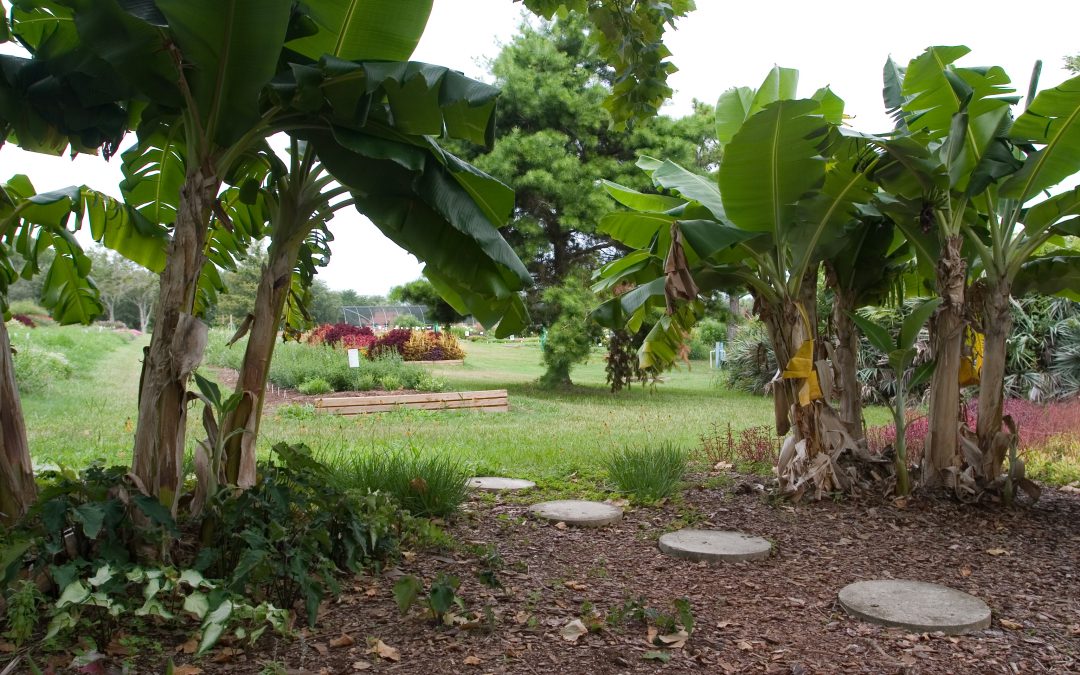
by Ray Bodrey | Feb 25, 2021
Bananas are a great choice for your landscape, whether as an edible fruit producer or simply as an ornamental, giving your space a tropical vibe.
Bananas are native to southeast Asia, however, grow well across Florida. Complementary plants that can be paired with bananas in the landscape are bird of paradise (banana relative), canna lily, cone ginger, philodendron, coontie, and palmetto palm, just to name some.
Bananas are very easy to manage during the warmer months. Bananas are water loving, and that’s putting it lightly. Planting in vicinity of an eave on your home is a good measure for site suitability. Roof rainwater will drastically increase the growth of the banana tree and decrease the need for supplemental irrigation. Banana trees will need full sun and high organic moist soils create the best environment. For nutrition, a seasonal one-pound application of 6-2-12 fertilizer is a good practice to sustain older trees. Young trees should be fertilized every two months for the first year at a rate of a half-pound.
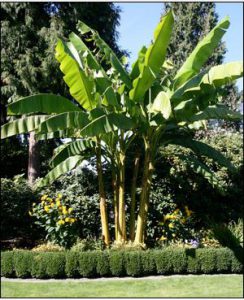
Musa basjoo is one of the most cold hardy banana varieties. Photo Credit: University of Florida/IFAS Extension
If there is a con to banana trees, it’s their cold hardiness. Some varieties fair well and others some not so much. ‘Dwarf Cavendish’ (Musa acuminate) is a popular variety that is found in many garden centers in the state. It produces fruit very well, but it is not very cold hardy. ‘Pink Velvet’ (Musa velutina) produces fruit with a bright pink peel, but isn’t very cold hardy either. A couple of cold hardy ornamental varieties are the ‘Japanese Fiber’ (Musa basjoo) and ‘Black Thai’ (Musa balbisiana), which is by far the most cold hardy, with the ability to easily combat below freezing temperatures.
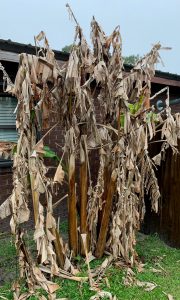
Freeze damage on a banana tree. Photo Credit: Ray Bodrey, University of Florida Extension – Gulf County
Regardless of cold hardiness, in many cases, banana trees will turn brown after freezing temperatures occur or even if the temperatures reach just above the freezing mark, but will bounce back in the spring. Until then, it’s important not to prune away the brown leaves or trunk skin. These leaves act as an insulator and help defend against freezing temperatures. Usually, the last freezing temperatures that may occur in the Panhandle are around the first of April. So, to be safe, pruning can begin by mid to late April. When pruning, be sure to be equipped with a sharp knife, gloves and work clothes. Banana trunk skin and leaves can be quite fibrous and the liquid from the tree can stain clothing and hands.
So, what’s the best variety of fruiting bananas? Most ornamental bananas do not produce tasty fruit. If you are looking for a production banana, ‘Lady Finger’, ‘Apple’, and ‘Ice Cream’ are popular varieties, but are better suited for the central and southern parts of the state.
For more information, contact your local county extension office.
Supporting information for this article can be found on the UF/IFAS Gardening Solutions website.
Also, for more information see the UF/IFAS EDIS publication, “Banana Growing in the Florida Home Landscape”, by Jonathan H. Crane and Carlos F. Balerdi.
UF/IFAS Extension is an Equal Opportunity Institution.
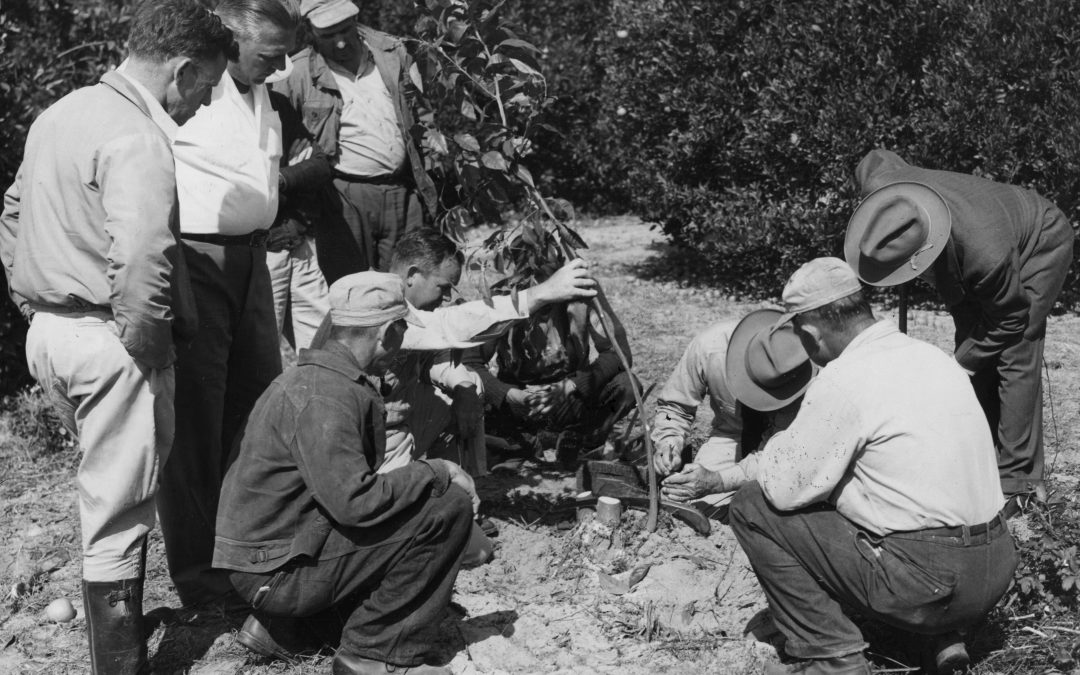
by Matt Lollar | Feb 18, 2021
It’s mid-February, cloudy, and cold. It’s time to get outside and take cuttings for fruit and nut tree grafting. The cuttings that are grafted onto other trees are called scions. The trees or saplings that the scions are grafted to are called rootstocks. Grafting should be done when plants start to show signs of new growth, but for best results, scion wood should be cut in February and early March.
Scion Selection
Straight and smooth wood with the diameter of a pencil should be selected for scions. Water sprouts that grow upright in the center of trees work well for scion wood. Scions should be cut to 12-18″ for storage. They should only need two to three buds each.
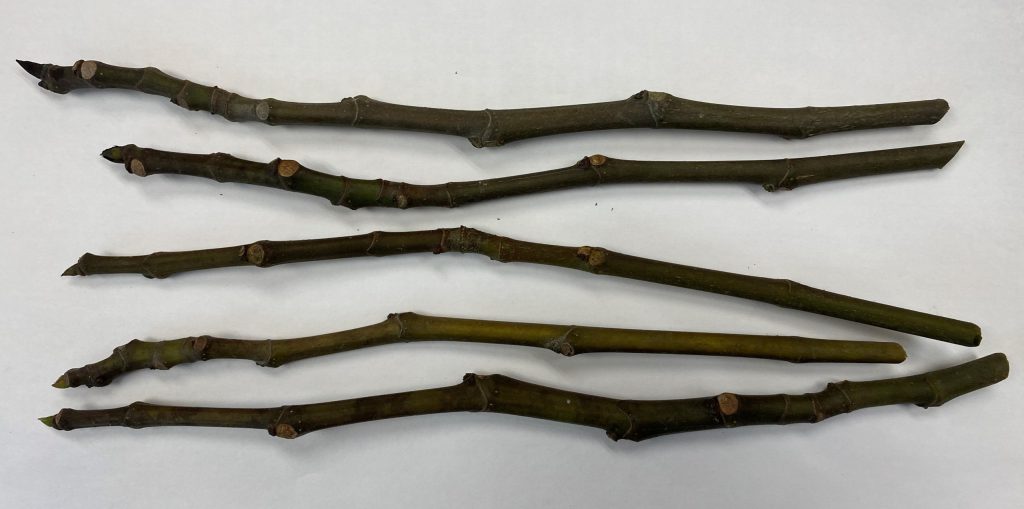
Scions ready for grafting. Photo Credit: Matt Lollar, University of Florida/IFAS Extension – Santa Rosa County
Scion Storage
Scions should be cut during the dormant season and refrigerated at 35-40°F until the time of grafting. If cuttings are taken in the field or far from home, then simply place them in a cooler with an ice pack until they can be refrigerated. Cuttings should be placed in a produce or zip top bag along with some damp paper towels or sphagnum moss.
Grafting
It is better to be late than early when it comes to grafting. Some years it’s still cold on Easter Sunday. Generally, mid-March to early April is a good time to graft in North Florida. Whip and tongue or bench grafting are most commonly used for fruit and nut trees. This type of graft is accomplished by cutting a diagonal cut across both the scion and the rootstock, followed by a vertical cut parallel to the grain of the wood. For more information on this type of graft please visit the Grafting Fruit Trees in the Home Orchard from the University of New Hampshire Extension.
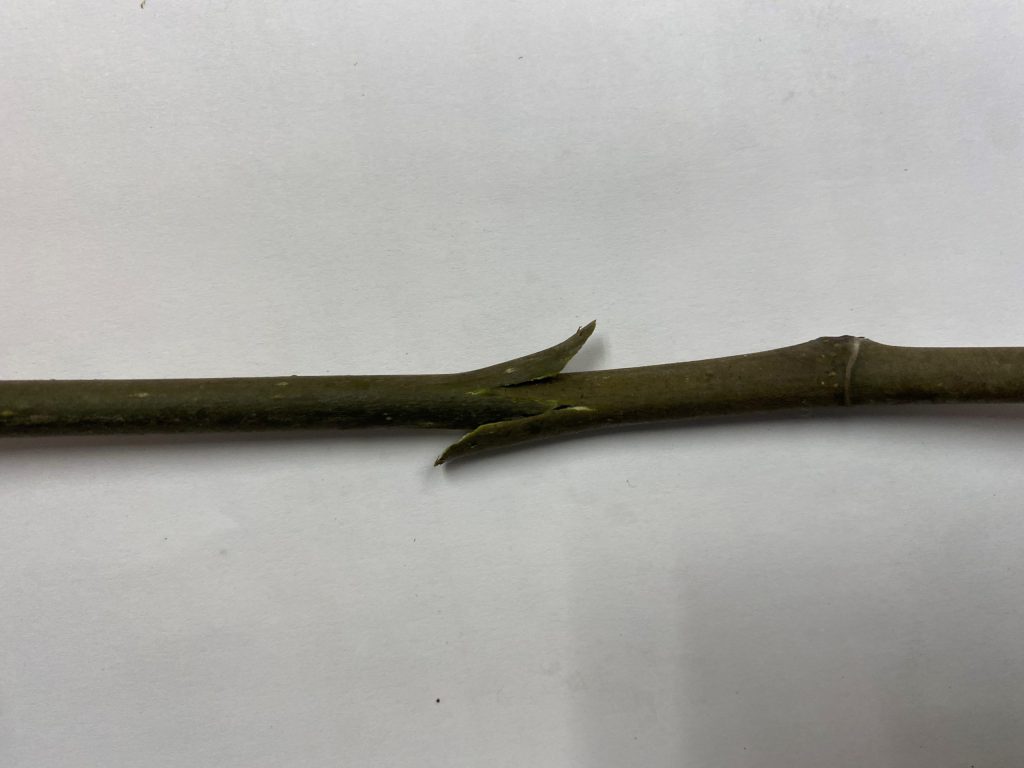
A bench graft union. Photo Credit: Matt Lollar, University of Florida/IFAS Extension – Santa Rosa County
Achieving good bench graft unions takes skill and some practice. Some people have better success using a four-flap or banana graft technique. This type of graft is accomplished by stripping most of the bark and cambium layer from a 1.5″ section of the base of the scion and by folding the back and removing a 1.5″ section of wood from the top of the rootstock. A guide to this type of graft can be found on the Texas A&M factsheet “The Four-Flap Graft”.
Grafting is a gardening skill that can add a lot of diversity to a garden. With a little practice, patience, and knowledge any gardener can have success with grafting.

by Ray Bodrey | Nov 4, 2020
Who doesn’t like strawberries, right? Backyard gardeners grow these low-growing herbs throughout the state and there is a significant commercial industry too, as Florida’s climate is ideal for cool season production.
Strawberries like well-drained sandy soils, so they’re a perfect fit for many areas in the Panhandle. Strawberries should be planted in the months of October or November as the plants are quite cold hardy. Shorter days and temperatures between 50°F and 80°F are ideal for fruit development.
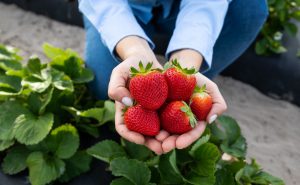
Photo Credit: Cristina Carriz, UF/IFAS
Strawberries are also very versatile. You can plant them in the ground, in raised beds or even containers. Transplants should be planted 12” to 18” apart, with 12” row spacing. For best results, use a rich soil balanced with compost and sandy soil and both fertilize and water regularly. Mixing in 2 ½ pounds of 10-10-10 fertilizer into a 10’ x 10’ bed space should be sufficient to start. A sprinkle of fertilizer applied monthly throughout the growing season should also help ensure a solid yield.
Berry production begins to ramp up roughly 90 days after planting, but plants will continue to produce throughout the spring. When the weather gets warmer, the plants start to expend energy into producing runners instead of fruit. These runners will be new fruit producing plants for next season.
Transplants can be purchased from most garden centers. There are many varieties on the market, but “Florida-Friendly” cultivars include “Sweet Charlie”, “Camarosa”, “Chandler”, “Oso Grande”, “Selva”, and “Festival”. “Camarosa” has proven to be the most productive variety in North Florida. Any of these varieties are capable of producing two pints of fruit per plant.
As stated earlier, Florida has a significant strawberry industry and UF/IFAS has a supporting role. The UF/IFAS Gulf Coast Research and Education Center (GCREC) is home to the Strawberry Breeding Program. Cultivars are developed by traditional means, for the Florida commercial industry on an 11,000+ acres research site. Appearance, shelf life, sweet flavor and disease resistance are just some of the areas of selected breading research that is conducted on site. There is also a white strawberry soon to be released!
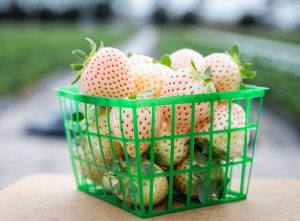
Photo Credit: Cristina Carriz, UF/IFAS
For more information, contact your local county extension office.
Supporting information for this article can be found at the website: https://gardeningsolutions.ifas.ufl.edu/plants/edibles/fruits/strawberries.html
UF/IFAS Extension is an Equal Opportunity Institution.









